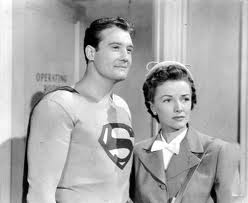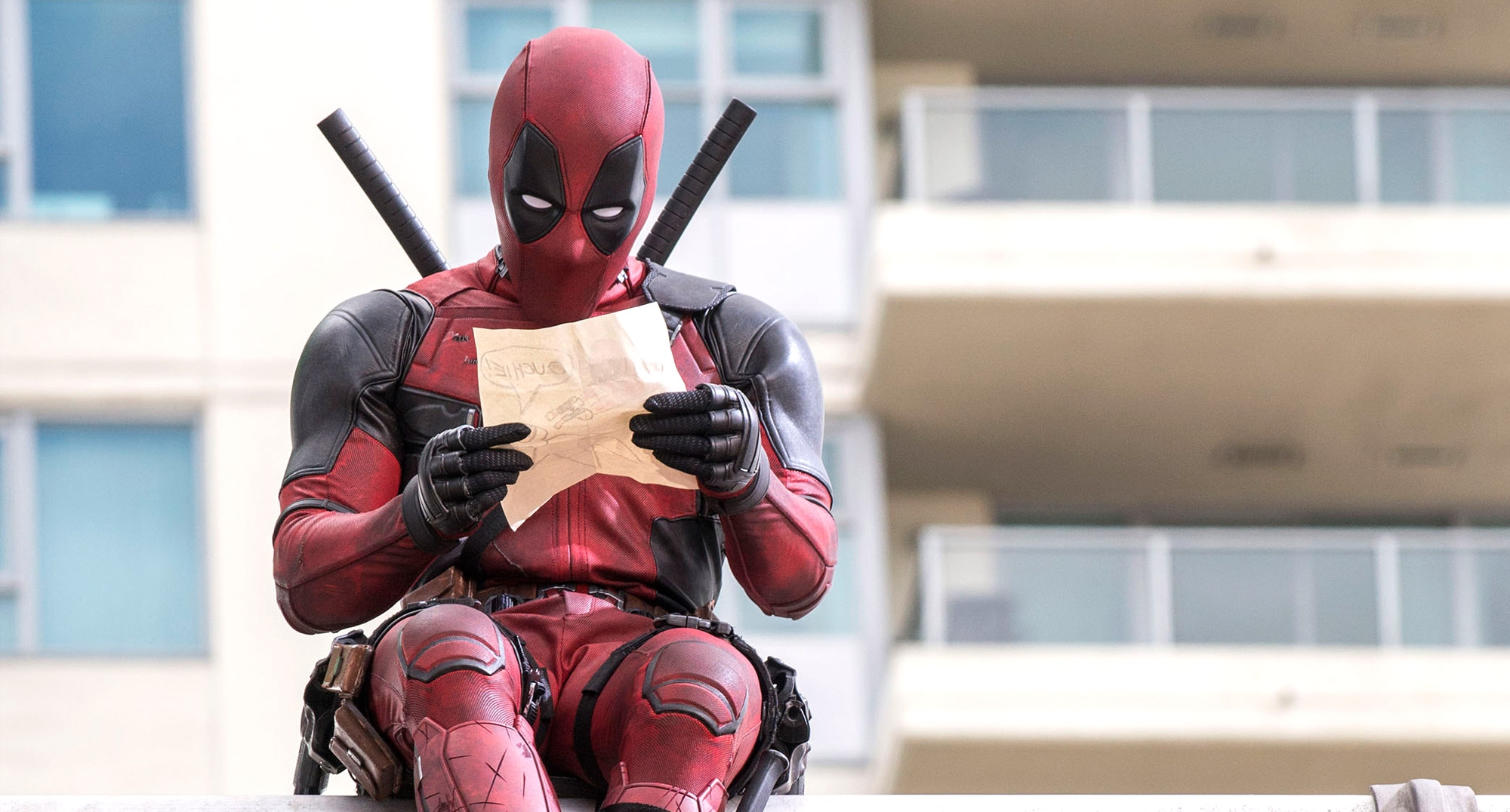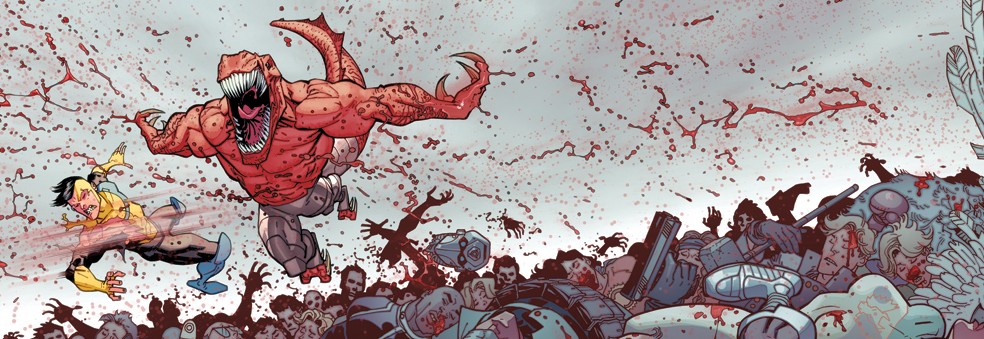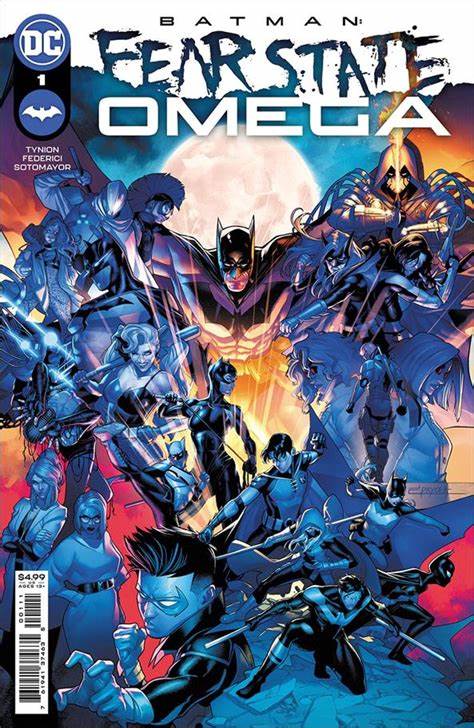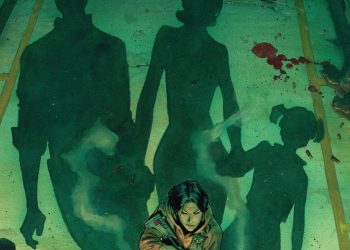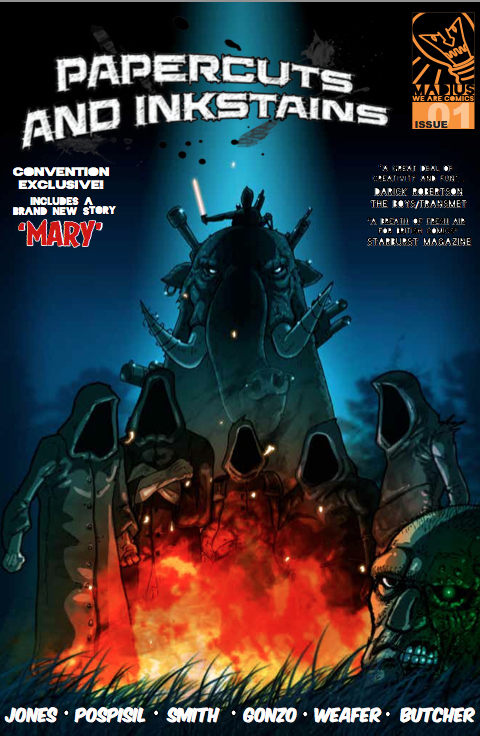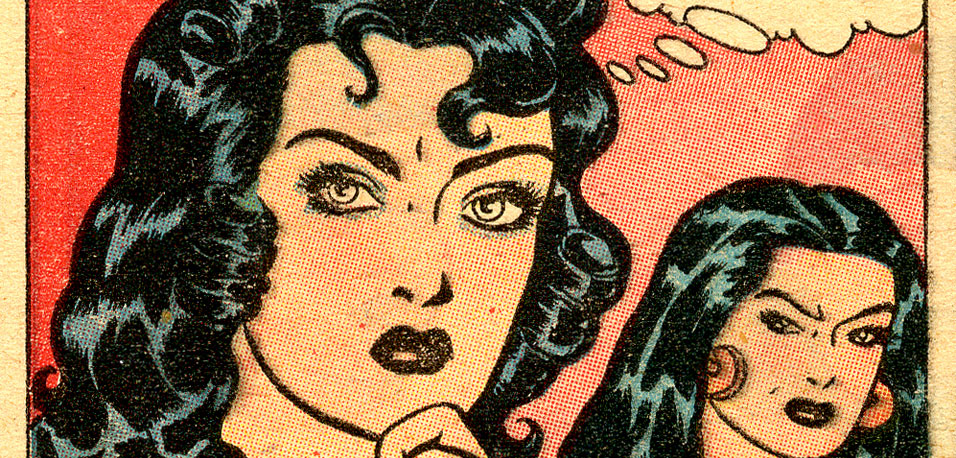[embedvideo id=”Q2l4bz1FT8U” website=”youtube”]
[youtube]http://www.youtube.com/watch?v=p0B1ufyXOds[/youtube]
As it’s “National Super-Hero Day”, I thought it only fitting to re-run this article that pays tribute to the television show that introduced me to the concept of super-heroism, and the man who will always be “My Superman”.
“The Adventures of Superman” & George Reeves; an appreciation by Bob Reyer
For a child of my generation growing up in the Fifties and Sixties, hearing the forceful voice of announcer Willard Kennedy intone the words “…and now, another exciting episode in The Adventures of Superman” was enough to send you a-scurry to your television set, as it meant that you had spent too much time in the kitchen gathering your snacks, and that another fantastic tale of everyone’s favorite super-hero was about to begin. It’s impossible to over-estimate the impact that the Adventures of Superman and its lead actor George Reeves had on audiences of the time, or how its influence continues to be felt through the works of comics creators and film-makers inspired by this long-ago program and the unforgettable performance of its star. With the trifecta at hand of the theatrical release of Man of Steel, Superman’s 75th birthday, and the June 16th anniversary of the passing of George Reeves, it’s a perfect time to take a loving look back at the first super-hero program in television history.
First, to put everything into context we’ll need to step back a little further in time. In 1940, barely a year after two Cleveland teen-agers named Jerry Siegel & Joe Shuster had seen their Superman explode across the pages of Action Comics #1, a syndicated radio show began entitled The Adventures of Superman. Produced by Robert Maxwell and starring Clayton “Bud” Collyer in the dual lead roles and Joan Alexander as Lois Lane, the program would become a nation-wide sensation when picked up for distribution by the massive Mutual Radio Network. The tremendous (and eventually decade-long) success of the radio show would prompt Paramount Studios and their animation partners Max and Dave Fleischer to undertake the production of a series of theatrical cartoons, the first of which, 1941’s simply-titled “Superman”, was nominated for an Academy Award. These glorious short gems are still regarded as some of the finest animated films ever made.
(From “The Magnetic Telescope” {1942})
Superman would return to the big screen in two Columbia Pictures cliffhangers starring Kirk Alyn in 1948 and 1950. Spirited but cheaply-made, these films would mark the live-action debut of the Man of Steel, which despite their budgetary issues would become the highest-grossing movie serials of all time. This success would pave the way for a leap into the new and exciting medium of television.
By 1950, as the halcyon days of adventure radio and movie serials were drawing to a close, National Comics/DC and producer Robert Maxwell were setting their sights on bringing Superman to the small screen. Without a sponsor, DC would balk at shouldering the cost of production for a complete 39 episode season, so their business manager Jack Liebowitz came up with the idea of making a short feature film that could be released theatrically and serve as a pilot, as well as raise capital to finance a 26-week season. The continuing and larger problem for producer Maxwell and his partner Bernard Luber was finding an actor to play Superman! (By the way, the film Superman and the Mole Men would premiere on November 23, 1951 and run for more than a year in some cities!)
Mr. Maxwell was not looking for a “muscle man”, but was instead seeking an accomplished actor who could embody the dual aspects of his lead character. After an exhaustive search and hundreds of auditions, the producers and newly-signed series director Tommy Carr selected a former Warner Brothers contract player named George Reeves, recently returned from two years in New York doing stage and live TV work. Mr. Reeves’ career had begun auspiciously with a small role in “Gone with the Wind”, but after that promising start and some good roles in “A” pictures before the War, by 1951 he found himself worse off than ever, with his work reduced to playing heavies in low-budget westerns and Sir Galahad in a kiddie matinee serial. At first reluctant to take the part, he took the job because he needed the money, and as he put it “I’ve played about every type of part you can think of. Why not Superman?”
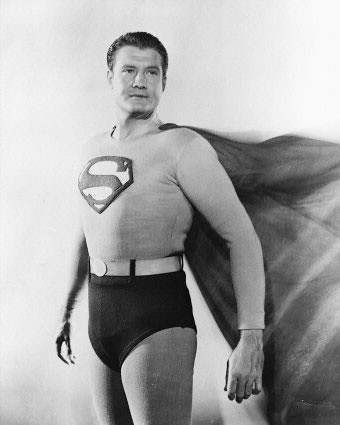
George Reeves and his first “Lois”, the feisty and alluring Phyllis Coates, completed the filming of ‘”Mole Men” in just 11 days, and after a week-end off embarked on shooting a season’s worth of episodes in a 13-week marathon where they were completing 4 shows every 10 days, each one budgeted at just $15,000, a low figure even then! This first season was basically an extension of the radio show, with plots heavy on gangsters and assorted ne’er-do-wells, with an atmosphere reminiscent of 40s film noir, although some science-fiction elements worked their way in, most notably the planet Krypton in the origin episode “Superman on Earth”. Within that framework were action-packed fight scenes, solid characterizations, and a sense of dark menace that truly made this first season a program for grown-ups. (George Reeves’ salary for that season–$600 a week for the 13 weeks.)
(George Reeves & Phyllis Coates)
Those episodes would sit on the shelf for more than a year until a sponsor could be found. Eventually, Kellogg’s Cereals, who had backed the radio show, entered into an agreement with DC to sponsor a nation-wide syndication deal, but they demanded some changes. With an eye toward a more family-friendly product, out went some of the more adult material, and eventually Robert Maxwell and Phyllis Coates, too. For the sophomore season, new producer Whitney Ellsworth brought back the Lois Lane of the serials Noel Neill, who came on board to join hold-overs Jack Larson (Jimmy Olsen), John Hamilton (Perry White) and Robert Shayne as Inspector William Henderson, who would all remain for the rest of the show’s 104 episode run.
By the time second season filming had begun, The Adventures of Superman had premiered around the country to good reviews and incredible ratings–an 88 percent share of sets in use in Atlanta for example! The lighter tone that Kellogg’s and Mr. Ellsworth envisioned for the series moving forward included more personal interest stories, but also sci-fi/comics trappings such as Kryptonite, computers, atomic radiation, time travel, robots, and wandering meteors in “Panic in the Sky”, perhaps the episode most like a Superman comic book. (And probably the source for the story in World’s Finest #68 “Menace from the Stars”!) The ratings would continue to be high, and the show would be one of the first to film in color beginning with the third season, but the plots would drift into more “kid’s show” territory until a bump upwards in the show’s sixth and final season.

(John Hamilton; George Reeves; Noel Neill; Jack Larson; Robert Shayne)
No matter the absurdity of the stories or situations, George Reeves’ portrayals of Clark Kent and Superman were never anything but dignified, powerful, and filled with bonhomie. His Clark Kent was a strong character in his own right, a crusading reporter often as feared by the criminals of Metropolis as his super-powered alter-ego, although he played them subtly differently. In the aforementioned “Panic in the Sky”, Superman has lost his memory, and trying to save the day, Clark Kent dons the costume he finds in the hidden closet in his apartment. Sitting slumped in a chair, glasses on, he is Kent; but when he hears reports that the meteor is about to crash, Clark slams his fist on a table in frustration–and it shatters! He stands, at first uncertain, until in what seems a visible upwards wave, Clark Kent transforms into Superman before our eyes!
According to those who would know, Clark Kent’s easy-going charm was a reflection of Mr. Reeves’ own personality, exemplified by the sign on his dressing room door “Honest George, The People’s Friend”, and the knowing verbal *wink* he would give the audience at the end of an exchange with Lois: “Well, all I can say is, if it wasn’t for Superman… I wouldn’t be here!”
A show about Superman will rise or fall on whether or not the actor playing him can deliver the twin attributes of physical power and emotional compassion. On the physical side, George Reeves was 6’2″ with an athletic build, although early on they insisted on padding the costume for enhancement. (This would be pared away as the series wore on.) His fight scenes, particularly in the no-holds-barred first season, were something to behold; raucous ballets of mayhem, with scads of evil-doers getting their come-uppance. Even after that, you always had the feeling that Superman was in total control, whether withstanding hails of gunfire or ray beams, preventing dams and railroad trestles from collapsing. lifting a pyramid or just simply coming into a room.
[embedvideo id=”Hh4WDyMvczA” website=”youtube”]
[youtube]http://www.youtube.com/watch?v=Hh4WDyMvczA[/youtube]
Superman’s entrances were spectacular, whether he was crashing through a wall, or via his landings which were accomplished by the athletic Mr. Reeves leaping from high ladders and swinging in on a trapeze bar hung just above the set. His dynamic take-offs were done (at least after some first season incidents regarding the wire rigging!) using a gymnastics springboard set below camera level. He would run up and then leap off the springboard through various windows and doors, seemingly flying through the air. The highlight moment for this technique can be seen in “Panic in the Sky”, where the camera was set well below an observatory walkway, and George Reeves ran to the edge and then vaulted completely over the camera; a fabulous practical effect for those pre-CGI days!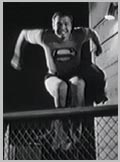
For all that fun though, what sets George Reeves’ Superman apart from all the rest was the human qualities with which he imbued him. Towards the criminal elements, Superman was presented as forthright and upstanding certainly, and with that unwavering need to see justice done, but it was tempered with compassion for those who had more “gone astray” than “turned evil”. If there was a way to provide a second chance, Superman would deliver. To Clark’s colleagues Lois & Jimmy, he was a supportive “big brother”, sometimes allowing them to wiggle out of trouble or find a scoop on their own so as to give them a sense of accomplishment. As in the early comics, he was a champion to the down-trodden, a campaigner for a better society, and a friend to children everywhere. Though these elements were in the scripts, it was due to Mr. Reeves’ wonderfully humanistic portrayal that these characteristics fairly leapt from the screen. In the brief clip below, from a first season episode entitled “The Birthday Letter”, Superman takes polio victim Kathie Williams on her wished-for “birthday flight”; watch as Superman is as thrilled as his young charge:
[embedvideo id=”cYDQlb7khZI” website=”youtube”]
[youtube]http://www.youtube.com/watch?v=cYDQlb7khZI[/youtube]
(I’m a basket case watching this, even after all these years!)
There was also a tinge of sadness that would peek through too, as Superman need always be somewhat apart from humanity as well. This would crop up in episodes such as “The Wedding of Superman” and “The Dog Who Knew Superman”, but was never more evident than in the final episode of the series, “All that Glitters”. One of three directed by George Reeves, it features a dream sequence where Lois and Jimmy have acquired super-powers of their own, and in the last scene, there is this exchange:
Jimmy: Golly Mr. Kent, you’ll never know how wonderful it is to be like Superman.
Clark: No Jimmy, I…I guess I never will.
These words, wistfully spoken, would be the final lines uttered on-screen by George Reeves before his untimely (and mysterious) death in 1959 at age 45. The Adventures of Superman, though slated for a seventh season, could not continue without its star. However, through syndicated re-runs, it would remain unceasingly on the air-waves for decades, serving as grand family entertainment, and as affirmation of the brilliance and rightness of Siegel & Shuster’s creation as interpreted by an actor who brought so much of himself to the role.
Although I’m sure the show seems quaintly primitive to younger eyes grown more accustomed to the whiz-bang of today’s special effects and the pacing of modern dramatic story-telling, for those of us who grew up watching, the Adventures of Superman was the height of invention, and for many of us, our introduction to super-heroes. Beyond that, it gave us more than a glimpse of true heroism as personified by George Reeves in the role of this “strange visitor from another planet”, providing inspiration for generations of children and adults alike.
SOURCES:
Superman: Serial to Cereal Gary Grossman (Popular Library/1977)
Adventures of Superman: From Inkwell to Backlot (Warner Brothers DVD/2005)
The Adventures of Superman: Seasons 1–6 (Warner Brothers DVD/2005-6)
Look, Up in the Sky! (Warner Brothers DVD/2006)
Flights of Fantasy Michael J. Hayde (BearManor Media/2009)
The George Reeves Historical News Archives Lou Koza (Lou Koza/2012)
(Also check Mr. Koza’s website “The Adventures Continue” @www.jimnolt.com)
Soundtrack:
The stirring ” Superman March” which you’ve heard here is credited to Leon Klatzkin, but it is quite possible that he “borrowed” elements from library music purchased for the show. Either way, despite all the years since first hearing it, when the harp glissandi begin, I never fail to be moved! rrr



